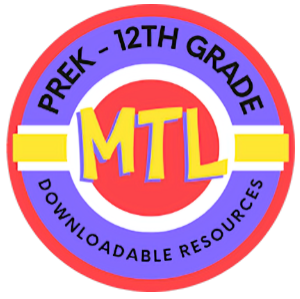Showing 1–20 of 62 results
-
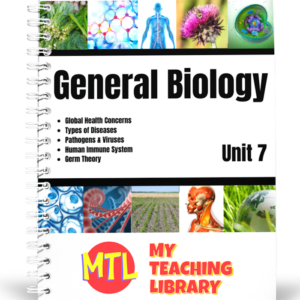 $6.00Buy Now
$6.00Buy NowBiology – Unit 7 is designed for high school students and focuses on global health, diseases, pathogens, viruses and more.
Lesson 1: Health Issues Throughout the World
Lesson 2: Types of Diseases
Lesson 3: Noninfectious vs Infectious Diseases
Lesson 4: Autoimmune Diseases and Hypersensitivity
Lesson 5: What is a Pathogen?
Lesson 6: Disease Control & Prevention
Lesson 7: The Study of Viruses
Lesson 8: The Human Immune System
Lesson 9: Vaccination & Immunotherapy
Lesson 10: Germ TheoryEach lesson includes written informational text and is followed by student questions and/or worksheets plus a unit test. Answer keys and optional assignments list is also included.
-
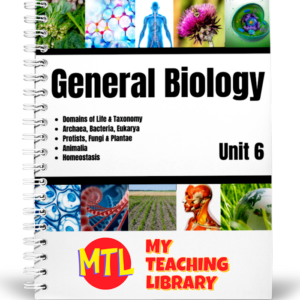 $6.00Buy Now
$6.00Buy NowBiology – Unit 6 is designed for high school students and is an in-depth study on the domains of life: Archaea, Bacteria & Eurkarya
Lesson 1: Domains of Life
Lesson 2: Archaea
Lesson 3: Bacteria
Lesson 4: Eukarya
Lesson 5: Taxonomy
Lesson 6: Protists
Lesson 7: Fungi
Lesson 8: Plantae
Lesson 9: Animalia
Lesson 10: HomeostasisEach lesson includes written informational text and is followed by student questions and/or worksheets plus a unit test. Answer keys and optional assignments list is also included.
-
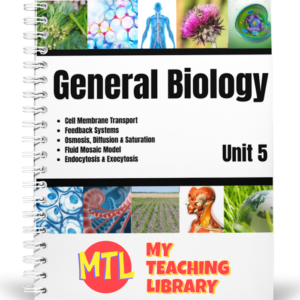 $4.00Buy Now
$4.00Buy NowBiology – Unit 5 will teach high school students all about the cell membrane and the transport of nutrients and waste.
Lesson 1: Transport Across the Cell Membrane
Lesson 2: Feedback Systems
Lesson 3: Osmosis, Diffusion and Saturation
Lesson 4: The Fluid Mosaic Model
Lesson 5: Active and Passive TransportEach lesson includes written informational text and is followed by student questions and/or worksheets plus a unit test. Answer keys and optional assignments list is also included.
-
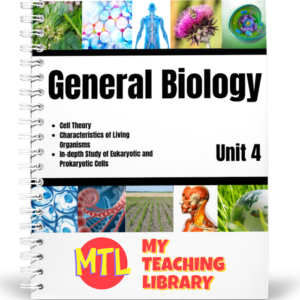 $5.00Buy Now
$5.00Buy NowBiology, unit 4 will teach high school students about cell theory, the characteristics of living organisms and includes an in-depth study of eukaryotic and prokaryotic cells.
Lesson 1: What are Cells?
Lesson 2: Cell Theory
Lesson 3: The Defining Characteristics of Living Organisms
Lesson 4: Eukaryotic and Prokaryotic Cells: Similarities and Differences
Lesson 5: Structure of the Cell Nucleus
Lesson 6: The Ribosome
Lesson 7: The Endomembrane System
Lesson 8: The Cytoskeleton
Lesson 9: Mitochondria Structure
Lesson 10: Cell Membrane
Lesson 11: Plant Cell Structures
Lesson 12: Chloroplast StructuresEach lesson includes written informational text and is followed by student questions and/or worksheets plus a unit test. Answer keys and optional assignments list is also included.
-
 $5.00Buy Now
$5.00Buy NowBiology, unit 3 will teach high school students about chemical and biochemical principles essential for life.
Lesson 1: Macromolecules
Lesson 2: Macromolecules In-Depth
Lesson 3: Properties of Carbon
Lesson 4: Enzymes
Lesson 5: Enzymes Regulation
Lesson 6: Energy Transformation
Lesson 7: Cellular Respiration (Part 1)
Lesson 8: Cellular Respiration (Part 2)
Lesson 9 Chlorophyll Absorbing Energy Light
Lesson 10: Photolysis and Light ReactionsEach lesson includes written informational text and is followed by student questions and/or worksheets plus a unit test. Answer keys and optional assignments list is also included.
-
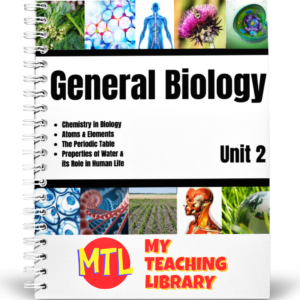 $4.00Buy Now
$4.00Buy NowBiology – Unit 2 will teach high school students about chemistry in biology: atoms, elements, the periodic table, the properties of water and the role water plays in living things, specific in the human body.
Lesson 1: Building Blocks
Lesson 2: Chemical Bonds
Lesson 3: Properties of Water
Lesson 4: Water and the Human Body
Lesson 5: Solutions, Solutes and SolventsEach lesson includes written informational text and is followed by student questions and/or worksheets plus a unit test. Answer keys and optional assignments list is also included.
-
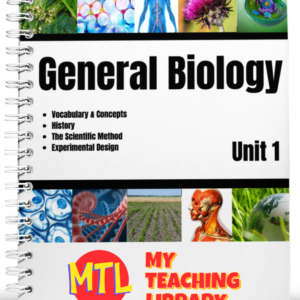 $4.00Buy Now
$4.00Buy NowGeneral Biology – Unit 1 will introduce high school students to Biology by defining it, giving history and explaining the scientific method. There are 6 lessons within the unit:
Lesson 1: Defines biology and major fields within it
Lesson 2: Various different fields and careers within biology
Lesson 3: The microscope
Lesson 4: History of biology
Lesson 5: The Scientific method
Lesson 6: The design of experimentsEach lesson includes written informational text and is followed by student questions and/or worksheets plus a unit 1 test. Answer keys and optional assignments list is also included.
-
Sale!
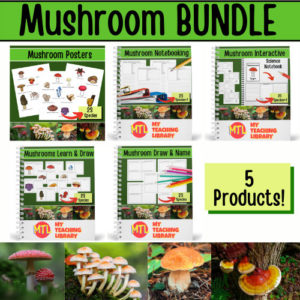 Original price was: $15.00.$12.00Current price is: $12.00.Buy Now
Original price was: $15.00.$12.00Current price is: $12.00.Buy NowMy Teaching Library has bundled 5 MUSHROOM products to help you SAVE and have a variety of fantastic classroom resources to help you teach…
- – If you teach Science for 6th-12th grades, this bundle is for you!
- – If you teach an outdoor nature-based class, this bundle is for you!
- – If you want to give your student(s) a fun, research-based unit study, this bundle is for you!
-
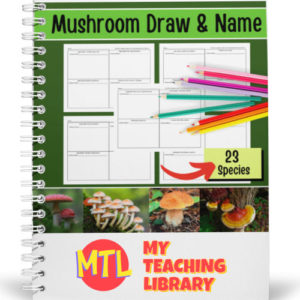 $2.00Buy Now
$2.00Buy NowMushroom worksheets designed for students to draw and write the common name of 23 given species. Perfect for any Science or Biology classroom studying fungi!
There are 6 worksheets (5 with 4 named species and 1 with 3). On each worksheets, students are to write the common name of the given species and draw a picture.
-
 $4.00Buy Now
$4.00Buy NowStudents will use these notebooking pages to record information about 23 different species of mushrooms. Perfect for a Science or Biology classroom studying fungi!
In addition to the named 23 species, student are given an extra page to add additional species if they choose (or if you instruct them to add others).
On each page, students will draw a picture of the species, give the complete scientific classification and record additional information they learn through research, reading books or using the current curriculum.
-
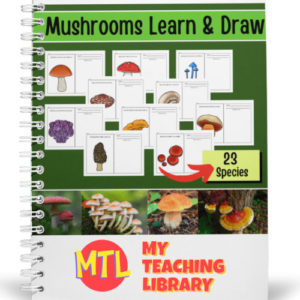 $3.00Buy Now
$3.00Buy NowStudents will learn 23 different type of mushrooms with this product. For each species of fungi, they will learn the binomial name and draw a picture. There are 23 different pages. On each page, there is a color picture of the named species. Students will copy the information given. (Alternative use: Have students fold the page in half and draw from memory.)
-
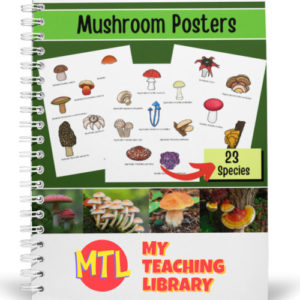 $3.00Buy Now
$3.00Buy NowSet of three mushroom posters for the classroom showing 23 different species. Perfect for any Science or Biology class studying fungi!
-
 $2.00Buy Now
$2.00Buy NowReady to use stages of mitosis worksheets that can be used as study aids or for quizzes / tests.
There are 4 worksheets:
- #1: Students will name each stage of mitosis in order
- #2: Students will draw / illustrate each stage
- #3: Students will name and draw each stage
- #4: Students will describe what is happening / events of each stage
Answer key provided
-
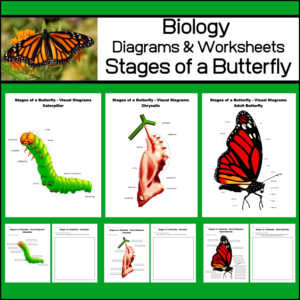 $3.00Buy Now
$3.00Buy NowThis Science / Biology resource provides diagrams (posters) and worksheets for 3 stages of a butterfly’s life cycle: caterpillar, chrysalis, adult. Each diagram is labeled and comes with 2 worksheets (1 with a picture and students will label each part; 1 for students to draw and label their own diagrams).
-
 $6.99Buy Now
$6.99Buy NowThis 6:44 minute video product has been created to give BIOLOGY / ANATOMY / HEALTH students an overview of the human body’s circulatory system! Student will learn the major components of the system (names of major arteries and veins as well as parts of the exterior and interior of the heart) as well as the function of the heart, arteries, veins, red blood cells, white blood cells, platelets and plasma.
-
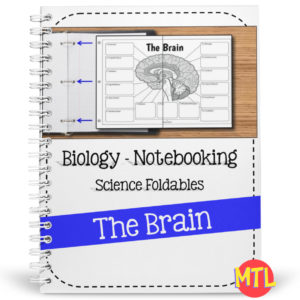 $3.00Buy Now
$3.00Buy NowHigh School Biology Notebook resource!
Students will learn all of the major parts of the brain including ventricles, cingulate gyrus, thalamus, hypothalamus, optic chiasm, pituitary gland, midbrain, pons, medulla oblongata, meninges, cerebral cortex, cerebrum, corpus callosum, pineal gland, cerebellum, occipital lobe, parietal lobe, temporal lobe, frontal lobe
-
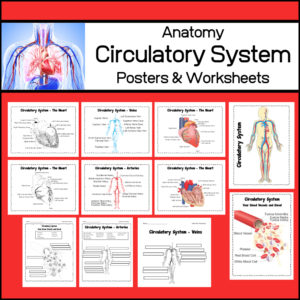 $4.00Buy Now
$4.00Buy NowThis Science / Biology / Health resource will help your students learn about the circulatory system of the human body! Included are 10 posters (each in color and b/w) and 5 different worksheets (each with and without a word bank)!
-
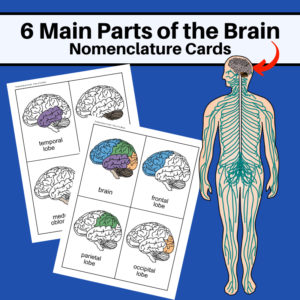 $2.00Buy Now
$2.00Buy Now6 Main Parts of the Brain – Human Anatomy Nomenclature Cards – This resource will help students learn and study the following parts of the brain: frontal lobe, parietal lobe, occipital lobe, temporal lobe, cerebellum and the medulla oblongata.
-
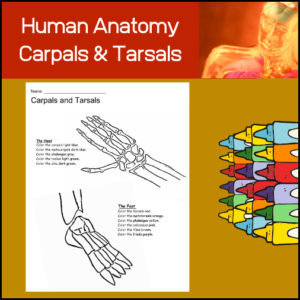 $1.25Buy Now
$1.25Buy NowOn this one page worksheet titled Carpals and Tarsals, students identify the bones of the hands (+ wrist and lower arm) and feet (+ lower leg): carpals, metacarpals, phalanges, radius, ulna, tarsals, metatarsals, phalanges, calcaneus, tibia and fibula.
Suggested uses: Use in a Science center when studying human anatomy, give as homework or use as a quick quiz. Answer key is provided.
-
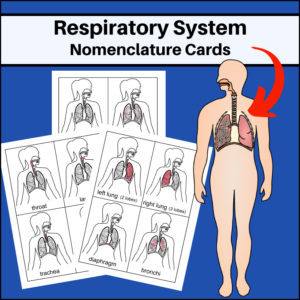 $2.00Buy Now
$2.00Buy NowRespiratory System – Human Anatomy Nomenclature Cards – This resource will help students learn and study the location of the following parts of the respiratory system: left lung, right lung, diaphragm, bronchi, bronchioles, alveoli, sinus cavity, nose, throat, larynx, trachea, and pleura. There are also 4 extra diagrams with no labels for you to use as you wish…such as give to students to have them color in and label the cards for themselves!
